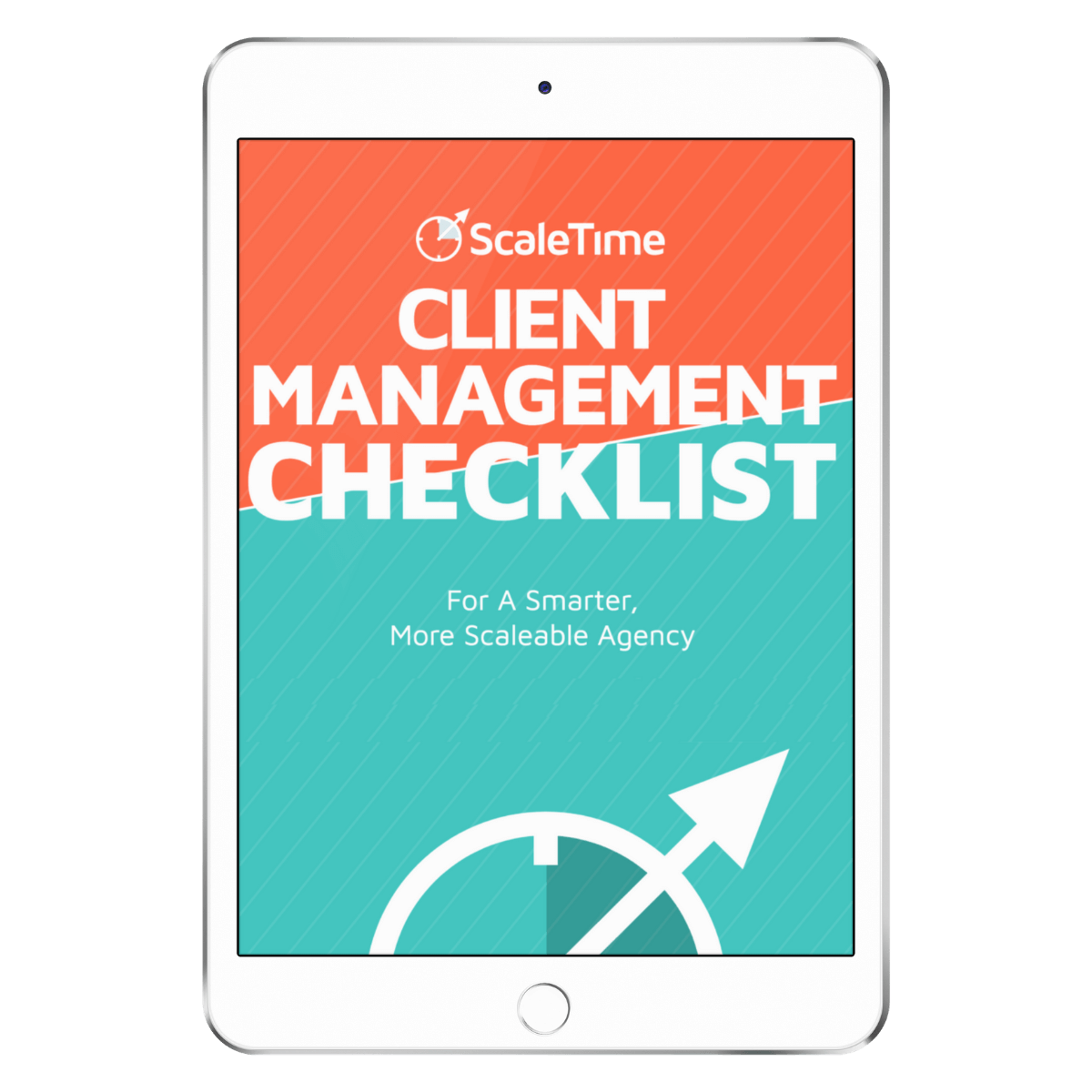Client Onboarding for Agencies
Build an Onboarding Machine. Bring More on Faster. Increase Revenue.

Ahh, the sweet, sweet smell of victory. You just closed that big-name client — time for a nice haircut and a vacation.
Hold up. Victory isn’t yours just yet. And you’ve still got some work to do.
That work being, have you actually onboarded that client?
AND have you onboarded them effectively?
If you don't have an airtight onboarding process your client will be:
Confused
Confusing
Annoyed
Annoying
Let’s avoid all that dissonant jazz, shall we? What you need for an airtight, effective onboarding process is the SCALE. framework.
Psst. And a free client onboarding toolkit. More on that later.
But first things first:
What's SCALE.?
Our proprietary SCALE. framework is a systematic, proven process for helping agencies scale and agency owners delegate confidently. It works for all processes in your business, including the client onboarding process.

So, what happens when you use SCALE. for client onboarding?
You get a business that runs like a smooth and kick as$ 21st century machine. And you get more harmony in your work-life integration.
Okay, so what exactly does this magical SCALE. Framework for client onboarding include?
Come along, children! We’ll break it down into five steps so you completely understand how smooth, streamlined, and no-more-pulling-your-hair-out easy our proprietary client onboarding process is.
The S in SCALE.
See what’s happening
See what’s happening
Client onboarding for agencies is a frequently overlooked but vital part of project management strategy. No matter what, you need the right information to be successful.
An effective, customized client onboarding process from your pals at ScaleTime will:
- Help you retain good clients you actually want to work with
- Set proper expectations on both ends of the deal
- Define success for your projects and deliverables
- Make new clients feel welcome and happy with their decision to work with you
This step in the process is like seeing your mise en place of client onboarding.
What ingredients do you have? Which ones do you need to make a gourmet client onboarding process that’s scalable and repeatable?
You have to uncover these little nuggets before forging the shiny gold coin of client onboarding success.
The C in SCALE.
Create a Baseline
Create a Baseline
This is the temp check. How’s it all going for you? Probably not good if you’re checking out this page.
Agency owners and project managers, do you keep running up against:
- You close clients, but you can’t seem to retain them
- Your projects keep getting out of scope and out of control
- Your clients don’t seem to know what it is you’re doing
- You’re not entirely sure what the client wants
- Expectations aren’t met, clients are mad, and workers confused
During the C stage of the SCALE. process, it’s all about that base ‘bout that baseline.
We pinpoint the process issues, benchmark where you are currently, and set a baseline. From here, we don’t have anywhere to go but up.
Next, we take the good things you’re doing, optimize, and amplify.
The A in SCALE.
Amplify how you do it
Amplify how you do it
You’ve seen commercial buildings continue to operate while undergoing renovations, right? We’ll do the same thing for your digital store.
Your business can’t just stop and it’s not going to. It’s hop aboard the moving train time and your operations can continue as we continue to tinker around with the guts of the business operations.
Here’s what happens:
We take the best of what you’re doing right, add what you should be doing, and get you where you want to be while continuing operations and keeping that money tap open.
And once it’s open? It’s time for you to lead and delegate.
The L in SCALE.
Lead and delegate
Lead and delegate
Once you’ve got your client onboarding process benchmarked and amplified with the good stuff, it’s time to ascend the throne of leadership, delegate, and get your team on track.
Your employees will be so much more relaxed, happy, and productive. They’ll know what needs to be delivered and where they’re succeeding with your clients.
The E in SCALE.
Exit and oversee
Exit and oversee
Time to get the hell out of the way.
This is what you’ve always wanted as a business owner — A company that scales on autopilot without you needing to constantly roll up your sleeves and play the part of reluctant firefighter.
Finally, you can enjoy your business’s growth and fully live your life outside of hand holding clients.
“Wow, ScaleTime! This sounds great! How do I get started with a kicka$$ client onboarding process for my business?”
Glad you asked! Keep on scrolling.
How ScaleTime Helps Agencies Take Control of Client Onboarding
So, here’s the first part of the problem that agencies run into with client onboarding:
Sales promises aren’t aligned with what your team is trying to deliver.
And it’s a huge problem that sets everyone up on the wrong foot from the get go.
With that said, the first part of how we help agencies with their client onboarding process is we make sure this doesn’t happen in the first place, so everyone is set up for success from the start.
We’ll help you:
- Setup client meeting kickoffs to align sales promises with deliverables
- Define your goals and metrics for success
- Create, download, and optimize your client onboarding process
- The result, smoother, more efficient processes and an agency that scales are waiting for you.
With an excellent, professional client onboarding process, you’ll retain more customers, banish the scope creep, and reach your business goals faster.
Get Started Today!
If you treat your clients like kings and queens they’ll keep coming back. Once you close the deal, you have to welcome and educate them with client onboarding.
If you’re in the weeds with your client onboarding, we’ll get you outta there with the tools, training, and collaboration you need.
Get started now with our FREE and kick a$ client onboarding checklist.
Just follow these steps to reach the pot of gold at the end of the happy, repeat client rainbow.
Step 1: Know your clients and anticipate their needs
Document everything your client is thinking about or worried about so you can take care of them before those questions pop up.
Create 4 lists:
- List of requests clients make before, during and after engagement
- List of concerns clients have during engagement
- List of signals that indicate other providers are trying to poach your clients
- List of which team members take on which types of projects
Step 2: Understand the top goals and define your metrics
The quality of your onboarding process plays out through the end of the engagement. Tracking certain metrics can help you identify opportunities to improve the process.
Here are the metrics you should setup and track:
- Average client lifetime — average time that clients hire you
- Client churn rate — the rate at which clients leave you
- Client Satisfaction Score — how happy clients are with your service
Step 3: Download your onboarding process
Think about what you do each time to onboard a new client? Then create a clear, repeatable, trackable process for onboarding to make sure nothing slips through the cracks.
Eg. Asana — workflow in a project manager

Step 4: Optimize the client onboarding process
PRE KICKOFF – TSA STYLE
Before you start with your client, you need to set some solid boundaries and clear expectations. Without them, they’ll step all over you. Even if they’re nice people and great clients.
Think of this like a TSA checkpoint. Nobody likes it. And if you do, wtf?
Regardless, everybody puts up with the TSA checkpoint because it’s a necessary part of flying and getting from point A to B as quickly as possible.
So when setting expectations, think about certain rules you have for your business, the processes that let you operate effectively, the challenges your client may face, and more.
This typically includes the following:
- How many meetings will you have with the client? How often?
- What happens if they contact you outside the guidelines?
- How long do you need them to review things?
- When will they be confronted?
- How do you reassure them?
- What happens when they don’t review?
- What are your hours of operation?
FOR THE KICKOFF MEETING
When you document exactly how you want kickoff meetings to go, you’ll be able to start quickly delegating to team members.
Requirements for kickoff documentation include:
- Agenda
- Timelines
- Who is in the room and how to address their immediate concerns
Be sure to keep in mind that your finance chick will have different needs than the marketing dude or intern who is a nepo baby but you still love them anyway.
- Anything that needs to be ironed out that wasn’t during sales
- What they lied about during sales
POST KICKOFF MEETING – ONGOING EDUCATION MATERIAL
Once it’s done, finish strong. Send the client a recap so you are both on the same page, and have proof of consensus.
Without this follow up, it’s like running a marathon and walking the last 1⁄2 mile because the hard part is behind you. Nah!
In your recap, you can include definitions of key terms and other educational material. This will give your client confidence that you’re the right person for the job and you can start to make them a more sophisticated client.
- High Level: what do people not know about your service, features, industry, delivery or progress?
- What do you wish they knew so you don’t have to spend time explaining during client calls?
SURVEYING YOUR CLIENTS
Surveys are key, not only to making this engagement a success, but also to getting your clients lining up to work with you again.
Feedback tells you how you and your team are doing, and how happy your client is. They also help increase retention and allow you to make changes to create a better customer experience.
Unfortunately, clients often let them slip by the wayside. All. The. Time.
To increase completion rates:
- Make surveys short and easy
- Set the expectation up front that you care about quality and will be surveying them, so they take the time to do it
Step 5: Delegate onboarding to an account manager
The faster you get this process documented, the faster you can offload it to an account manager. Hooray!
To know how valuable it is to offload this process, document how long it takes to typically onboard a client, and any costs involved in the process.
THE FIRST STEP IS DEFINING YOUR ONBOARDING BUDGET
- Document:
1. How long does it take you to onboard a client?
2. How many team members do you need?
3. How much does it cost?
4. What technologies are needed?
5. Do you need a space for onboarding?
Our client Darren, owner of a digital marketing agency, saved 20 hours per client by hiring a Success Manager and delegating his onboarding process!
PROCESS, DOCUMENTS & MATERIALS:
- Select internal team to lead onboarding using the following criteria:
1. Who has the best understanding of this service or industry
2. Who has bandwidth to service this client
3. Whose style is in sync with this client - Create a client brief
1. All the information gathered during the sales process that a team member will need to know and add to in order to service the client - Organize client documents & resources that you need (intake)
1. Identify what you need from the client to move the project forward ie. credentials, assets, strategy documents
2. Create a Plan B – What will you do when you realize they don’t have these items and they lied to you (p.s. 99% of the time, they did). - Create a client welcome pack
1. Send a welcome letter (or film a welcome video if you want to leave a GREAT impression) that reassures your client’s decision to work with you + add anything else needed to make sure they’re a good behaving client - Define client metrics, create a client dashboard. This includes:
1. How do you measure client success?
2. How do you know if the client is being served at excellence?How do you know deadlines are being met? - Document client definitions and resources
1. Answer to common questions your clients constantly ask
2. Note: This is an opportunity to educate clients and have them prepared for upcoming pain points - Build a client folder taxonomy
1. Define standard folder structures
2. Define standard naming conventions
3. Create processes for storing and keeping track of version/iterations of deliverable
Pssst — This is almost always overlooked and always drives people crazy in the future.
CLIENT DASHBOARD
Build a dashboard to keep track of your activity and results, so you know your team’s progress
Your dashboard should include:
- Deadlines and milestones
- A signal that clients are on track or off track to succeeding. For this, you could use color gradients as status indicators.









%20(1).gif)




